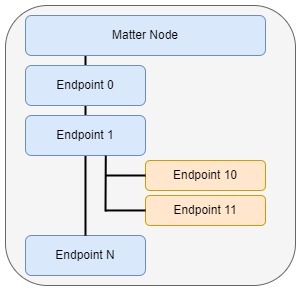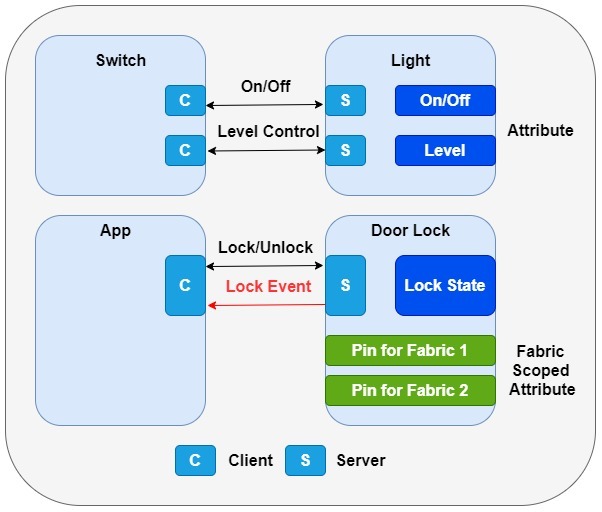The Matter Data Model#
The Data Model in Matter describes a hierarchical encapsulation of data elements in the Matter network, including, but not limited to, nodes, endpoints, clusters, and device types, where the node is the highest level data element.
A single physical Matter device, such as a light, switch, or door lock, can be represented by one or more nodes. An environment where multiple Matter nodes interoperate is referred to as a Matter fabric. These nodes share a common root of trust. On each separate fabric, a physical Matter device is represented by a node. Every node has a unique network address (Operational Node ID) that makes it uniquely identifiable in the fabric it is on. For example, in the following figure a Matter Lighting device on an Apple HomePod fabric (blue) has an operational node ID unique to the HomePod fabric and a Matter Switch device on a separate Samsung SmartThings Station fabric (red) in the same home has an operational node ID unique to the SmartThings fabric. These IDs may be the same or different; they are independent of each other because they are on two different fabrics.
A Matter device may also be part of more than one fabric and thus is represented on each different fabric by a different node. In following figure, a Matter Door Lock device is on both the HomePod and SmartThings fabrics. Thus, the Door Lock is represented by two different nodes; one for the HomePod fabric and another for the SmartThings fabric. The operational node IDs for the two nodes representing the device may be the same or different; the IDs are independent of each other because the nodes are on two different fabrics.


The following section describes the Matter data model, including Nodes and Device Types.
Nodes#
In the following figure, the hierarchical structure of endpoint, cluster, attributes/commands/events is shown from left to right.


Each node contains the complete application functionality for its device on a single stack. Because of this, nodes can communicate directly with other nodes on the network without the need for an intermediary.
Nodes have a set of related behaviors, known as a role. There are a few main node roles:
Commissioner - Commissions/adds new devices to a Matter network
Controller - Controls one or more nodes
Controlee - Can be controlled by one or more nodes
Over the Air (OTA) Provider - Provides OTA software updates to the OTA Requestor
OTA Requestor - Requests OTA software updates from the OTA Provider
Endpoints#
Endpoints enclose one component of a node’s complete functionality; together, they encapsulate all the node’s capabilities needed for functional wholeness. A smart thermostat, for example, could have two endpoints where one would implement the temperature control functionalities and another would implement the temperature monitoring functionalities.
Each of these endpoints are known as a feature set, which is made of clusters that define the attributes, events, and commands of a single endpoint's functionality. There are two distinct types of endpoints in Matter: leaf endpoints and composed endpoints.
Leaf endpoints, such as Endpoints 0, 10, and 11 in the following figure, do not require other endpoints to function.
Composed endpoints, such as Endpoint 1 in the following figure, require other endpoints to function. Connector lines indicate the endpoints that a certain endpoint has access to.


Nodes have numbered endpoints starting from 0 that contain their own feature set. Endpoints with the same number but on different nodes may enclose different feature sets. The exception is Endpoint 0, which is reserved exclusively for Utility Clusters. These special clusters are specifically used for enclosing a node’s servicing functionality: the discovery process, addressing, diagnostics, and software updates.
Endpoints are individually addressable to easily modify feature sets separately.
Clusters#
Clusters are collections of data that group the attributes, events, and commands of a specific functionality, representing a single feature in an endpoint’s feature set. A cluster may be thought of as an interface, service, or object class and is the lowest independent functional element in the device data model. Endpoints have multiple clusters to create individual instances of the same functionality for easier unit control. For example, each light on a light strip may have its own designated cluster for independent access.
Attributes, events, and commands make up clusters:
Attributes represent the current state, configuration, or capability of a node, for example whether a light is on or off, or if a switch is up or down.
Fabric-scoped attributes are only accessible to devices in the same fabric.
Attributes can be of uint8, string, array, etc. data types.
Commands are actions that a cluster can perform, analogous to verbs in the English language.
Commands always have a direction, either from client to server or vice versa.
The target can reply to the command in one of two ways:
Request - such as toggling the ON/OFF attribute of a server cluster representing a light.
Response - such as sending a success status, or an error/unsupported status.
Events are a record of past transitions between states of the node.
Events include data for a timestamp and priority of each change, as well as a monotonically increasing counter to track the number of state changes.
They are useful in capturing state transitions and modeling past data that attributes do not store.
Clusters have two main types:
Server cluster - Stateful, holds the data for the attributes, events, and commands.
Client cluster - Stateless, interacts with other server clusters by reading and writing attributes, reading remote events, and/or invoking methods.
Any cluster can be a server or a client, giving nodes the ability to both store information and horizontally communicate with other nodes. For a light and switch example, a client cluster in the light would send a command to a server cluster in the light to toggle the on/off feature of the light. The following figure illustrates examples of cluster communication. On the top is a light and switch example and on the bottom is an app controlling a door lock.


Device Types#
Device types are a collection of clusters on their respective endpoints that define top-level attributes of the physical device they represent. Device types can require other types for operational purposes; these are known as composed device types and require composed endpoints.
A device can be made up of any combination of clusters. Therefore, to ensure the interoperability of devices from different manufacturers on a single network, Matter defined sets of requirements for official device types in the Matter Device Library for users to implement and extend. Every definition contains the device type ID, type revision number, and mandatory cluster(s) with their minimum revision number. Device Types are constantly updating, with each iteration tracked using the revision number starting from 1. However, changes to a device type's definition do not change its functionality, but only serve to improve operation. It is also important to note that newer versions of a device will continue to interoperate with older revision levels.
The device types that Matter supports are an unyielding requirement for Matter nodes. Nodes that implement certain device types are required to include feature sets of clusters on one or more endpoints for the said device type. A node cannot implement a device type if it does not have all the required feature sets. Official documentation lists the application device types that Matter supports in the Device Library Specification, while the respective supported application clusters are defined in the Application Cluster Library. These two documents, along with Chapter 7: Data Model Specification of the Matter specification document, can be found on the website for CSA members: Specifications Download Request - CSA-IOT.
Relating Matter to Zigbee#
Ultimately, Matter serves to extend existing protocol stacks to maintain and bolster their architecture for future use. Thus, the Data Model originates from and resembles the Dotdot Architecture Model found here: https://groups.csa-iot.org/wg/matter-tsg/document/18649 and Chapter 2 of the Zigbee Cluster Library Specification found here: https://groups.csa-iot.org/wg/members-all/document/23019. The Matter Data Model better defines the architecture in the Zigbee Cluster Library while keeping the certifiable cluster specifications.
